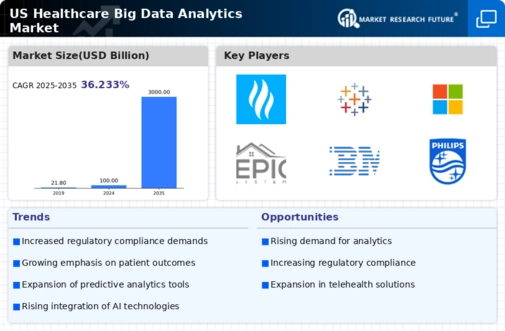The US Healthcare Big Data Analytics Market has witnessed significant growth in recent years, driven by an increasing need for efficient healthcare management, improved patient outcomes, and the rising importance of data-driven decision-making. The competitive landscape is characterized by a diverse range of players, including established technology firms and specialized analytics companies. These entities are competing to offer advanced analytics solutions that can harness large volumes of healthcare data, enabling providers to gain insights into patient care, operational efficiencies, and public health trends.
This competitive environment has fostered innovation, resulting in the development of sophisticated tools that cater specifically to the needs of healthcare organizations looking to leverage big data effectively.
Health Catalyst has established a strong position in the US Healthcare Big Data Analytics Market by providing a comprehensive suite of analytics solutions that focus on improving clinical and financial outcomes. The company’s strengths lie in its robust data integration capabilities, which allow cohesive access to disparate data sources, enabling healthcare organizations to gain valuable insights. Furthermore, Health Catalyst's emphasis on actionable intelligence allows healthcare providers to implement data-driven strategies to enhance patient care and operational efficiency.
The firm's commitment to fostering collaborations with various healthcare stakeholders has also strengthened its market presence, as it continuously expands its portfolio to respond to the evolving challenges faced by healthcare systems in the United States.
Tableau is recognized as a leading player in the US Healthcare Big Data Analytics Market, offering powerful data visualization and analytics tools designed to help healthcare professionals make sense of complex datasets. With key products that foster interactive dashboards and real-time analytics, Tableau enables healthcare organizations to visualize and analyze data effectively, promoting informed decision-making. The company has built a strong market presence through strategic partnerships and integrations with other healthcare technologies, enhancing its product offerings. Tableau's focus on user-friendly design empowers clinicians and administrators to engage with their data intuitively.
The firm has pursued mergers and acquisitions to broaden its capabilities and maintains a robust customer base in the healthcare sector, providing tailored solutions that address the unique analytic challenges faced by US healthcare providers, including improving patient engagement and operational workflows.























Leave a Comment